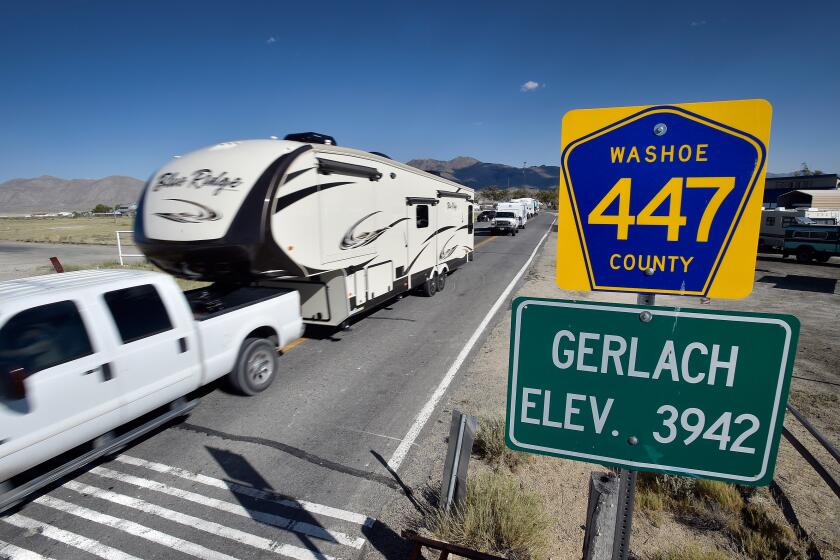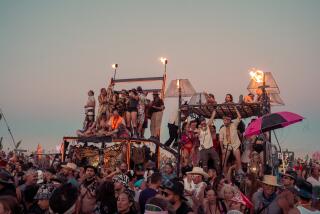Rain, mud cause upheaval at Burning Man festival

- Share via
As skies cleared Saturday night over the Burning Man festival in northwestern Nevada, tens of thousands of attendees ventured out from the tents and RVs where they’d been instructed to hunker down. But if they were hoping to watch the incineration of the festival’s eponymous wooden effigy, they were disappointed: The soggy weather prompted a postponement of the climactic ceremony.
After heavy rain Friday night turned the desert into a plain of mud, festival-goers had been told to conserve food, water and fuel and to shelter in place earlier Saturday. The downpour led organizers to close the gate and airport in and out of Black Rock City — the temporary desert metropolis that springs up each year for the festival.
But patches of sun began peeking out from the cloudy sky in the late afternoon, allowing a partial resumption of the annual celebration of art, expression, community and “radical self-reliance,” as festival founders described it.
Karole Holland-Hagino, who was attending her first festival with her son, said she was in a camp with about 125 people, and although the rain and muddy grounds made it hard to walk, she strolled the grounds for about four hours Saturday, barefoot. She dismissed social media rumors of Ebola virus and other outbreaks at the festival, saying there was no truth to them “at all” and everyone was “healthy and happy.”
“I gotta go ... party time,” she texted. “Everyone is great and everyone adapting.”
The chance of rain dropped to 10%-15% Saturday evening and was likely to stay that way through midnight, said Heather Richards, meteorologist with the National Weather Service in Reno. She said the chance of rain would rise to 50% after that and increase to possibly 70% on Sunday — potentially complicating efforts to leave the site.
By 8:30 p.m., the Burning Man live webcast showed a pitch black scene with flickers of light from festival-goers. But the fireworks show and immolation of The Man remained a scratch.
In a statement, Burning Man said the community was “well-prepared for a weather event like this,” having practiced drills and “engaged full-time on all aspects of safety.” Mobile cell trailers would be set up Saturday night, and buses would be deployed to help people leave. Organizers were in “constant communication” with local, county, state, tribal and federal officials Saturday, said the statement sent by festival spokesperson Dominique Debucquoy-Dodley.
“We will all get out of this, it will just take time,” the statement said.
The Reno Gazette-Journal reported that more than 73,000 people are currently at the festival.
Officials from the U.S. Bureau of Land Management and the Pershing County Sheriff’s Office have closed all entrances for the remainder of the event.
“Participants inbound for the event should turn around and head home,” the Bureau of Land Management said in a statement. “Rain over the last 24 hours has created a situation that required a full stop of vehicle movement on the playa.”
Places adjacent to the festival received a half-inch of rain or more between Friday and Saturday mornings, according to Mark Deutschendorf, a meteorologist at the National Weather Service office in Reno.
Burning Man organizers reported that Black Rock City received 0.6 to 0.8 of an inch of rain overnight.
“We have a higher chance of another round of steady rain later tonight into Sunday morning that could bring another tenth to a third of an inch, possibly even up to half an inch if it persists,” he said.
The rain should move out of the area by Sunday evening, he added.
The weather at this year’s festival is in stark contrast to last year, when temperatures were in the triple digits, reaching 105. Temperatures were forecast to be in the low 70s on Saturday and possibly drop into the 60s on Sunday.
“We’re going the other direction, a cooler and wetter Burning Man weekend,” Deutschendorf said. “If anyone goes, they have to prepare for either extreme.”
Before leaving Ojai for Burning Man, Tara Saylor faced the threat of Hurricane Hilary. Less than 24 hours after she left, a 5.1-magnitude earthquake hit her city, tumbling wine glasses in her kitchen.
When Saylor reached Nevada and tried to get into the festival on Aug. 21 to set up, she and her camp mates weren’t able to get in because of the rain.
They waited two days, leading them to jokingly call it “Waiting Man.”
Once they were at the festival, the rain descended on them again Friday afternoon, creating bowls of water in shaded structures and turning the alkaline lakebed into “a cakey mess.”
The mud coated bike tires, and people were forced to carry bikes on their backs. Saylor pulled trash bags over her waterproof boots to be able to slide through it.
Saylor said it took some campers an hour and a half to walk about eight blocks.
“You’ve got the hurricane, you’ve got an earthquake and now a flood,” she said.
Saylor said she’s seen the founders of two different companies at Burning Man this year, but added, “it doesn’t matter how much money you have, nobody can do anything about it. There’s no planes, there’s no buses.”
“Money does not solve disasters like this.”
Saylor is “mayor” of her camp, Pickle Planet, which consists of about 100 campers. Their offering to the pop-up city is pickleball and a pickle back bar, which is whiskey and pickle juice.
The bar stayed open through the storm Friday, with people stopping for respite as they trudged back to their own camps.
“Can we just have a shot of whiskey and we’ll be on our way?” campers asked. “We’ve got to keep trekking but we need warmth.”
When the rain hit, Saylor, who works in disaster management back home, quickly took stock of the camp’s fuel, food and communal spaces. The camp has water totes, with around 500 gallons of water. It also has its own porta-potty, she said, but most camps don’t.
She worried about bigger camps that rely on deliveries of fuel and water and to have their porta-potties pumped out.
“That’s what I would worry about the most is the sanitation issue that might come about,” she said. “Where are you going to start pooping if the porta-potties are full?”
“I wonder if at some point there’s going to have to be some intervention here,” she added. “What do you do about the sanitation issue? What do you do about the food issue? People were planning to leave today and tomorrow.”
The plan for the day? Saylor said she brought board games like Everdell and Azul and that camp mates might “braid each other’s hair, play cards, just try to keep morale high as possible.”
She said she powers down the generator at night so they’re not using up fuel. She has to stretch half a tank for maybe three or four days. “Burning Man is radical self-reliance, and we’re being put to the test,” Saylor said.
Later Saturday, Saylor said many people were walking four to five miles to the road and getting drivers to pick them up. But she said she and her camp mates were “doing great,” playing many games of pickleball. One camp mate even got engaged.
Richards, the meteorologist, said it would take some time for the puddles to evaporate and advised people to wait until the ground had dried out a bit before trying to drive over it in heavy vehicles.
“Playa mud is so thick that you’ll sink right into it and be stuck there for a while,” she said.
She added that this year’s festival was the third time she’s monitored it from her Reno weather station. “I have yet to see anything like this,” she said. “People are having a terrible time navigating.”
Climate and anti-capitalist activists blocked a road leading to Burning Man, creating gridlock and leading to clashes with motorists and tribal rangers.
The rain was not the only complication for this year’s festival-goers. On Aug. 27, opening day, climate and anti-capitalist activists blocked a road leading into Burning Man, creating miles of gridlock.
According to a statement from Seven Circles, a coalition of activist groups who organized the protest, the blockade aimed to spotlight “capitalism’s inability to address climate and ecological breakdown.”
More to Read
Sign up for Essential California
The most important California stories and recommendations in your inbox every morning.
You may occasionally receive promotional content from the Los Angeles Times.













